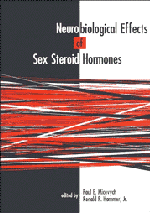Book contents
- Frontmatter
- Contents
- List of contributors
- Dedication
- Preface
- Acknowledgments
- Part I Sex steroid–responsive circuits regulating male and female reproductive behaviors
- Part II Sex steroid interactions with specific neurochemical circuits
- 5 Ovarian steroid interactions with hypothalamic oxytocin circuits involved in reproductive behavior
- 6 Sex steroid regulation of hypothalamic opioid function
- 7 Effects of sex steroids on the cholecystokinin circuit modulating reproductive behavior
- 8 Cholinergic regulation of female sexual behavior
- 9 Sex steroid regulation of tachykinin peptides in neuronal circuitry mediating reproductive functions
- 10 Dopaminergic influences on male rat sexual behavior
- 11 Studying neurotransmitter systems to understand the development and function of sex differences in the brain: the case of vasopressin
- Part III Cellular and molecular mechanisms regulated by sex steroids
- Index
8 - Cholinergic regulation of female sexual behavior
Published online by Cambridge University Press: 15 October 2009
- Frontmatter
- Contents
- List of contributors
- Dedication
- Preface
- Acknowledgments
- Part I Sex steroid–responsive circuits regulating male and female reproductive behaviors
- Part II Sex steroid interactions with specific neurochemical circuits
- 5 Ovarian steroid interactions with hypothalamic oxytocin circuits involved in reproductive behavior
- 6 Sex steroid regulation of hypothalamic opioid function
- 7 Effects of sex steroids on the cholecystokinin circuit modulating reproductive behavior
- 8 Cholinergic regulation of female sexual behavior
- 9 Sex steroid regulation of tachykinin peptides in neuronal circuitry mediating reproductive functions
- 10 Dopaminergic influences on male rat sexual behavior
- 11 Studying neurotransmitter systems to understand the development and function of sex differences in the brain: the case of vasopressin
- Part III Cellular and molecular mechanisms regulated by sex steroids
- Index
Summary
Acetylcholine was the first endogenous chemical to be identified as a neurotransmitter. In addition to its vital role in physiology, acetylcholine has been implicated in the regulation of mammalian behaviors that range from reflexive (Potter et al. 1990) to regulatory (Hagan et al. 1987) to cognitive (Levin et al. 1990). The control of these heterogeneous behaviors appears to be possible because of diffuse cholinergic circuits distributed throughout the mammalian brain (Mesulam et al. 1983). The organization of these systems, particularly in the forebrain and midbrain, places cholinergic neurons in regions involved in sensory, motor, and motivational processes.
Our work during the past decade has indicated that cholinergic systems also play an important role in the regulation of certain behaviors exhibited by mammalian females during mating. It is well known that the sexual behaviors of female rodents are controlled closely by steroid hormones, primarily estrogen and progesterone secreted by the ovaries. However, the sequence of neural events initiated by these hormones to cause complex behavioral responses has not been described fully. The capacity of cholinergic mechanisms to affect rodent sexual behavior suggests a key interface between endocrine activity and cholinergic function. Our primary hypothesis states that ovarian steroids regulate brain function, and consequently behavior, by altering the activity of cholinergic systems within neural target structures. According to current theories of hormone action, steroids could access nuclear genomes (O'Malley and Means 1974) and surface membranes (Schumacher 1990) to alter the nature and number of various proteins associated with cholinergic neurotransmission.
- Type
- Chapter
- Information
- Neurobiological Effects of Sex Steroid Hormones , pp. 184 - 206Publisher: Cambridge University PressPrint publication year: 1995



